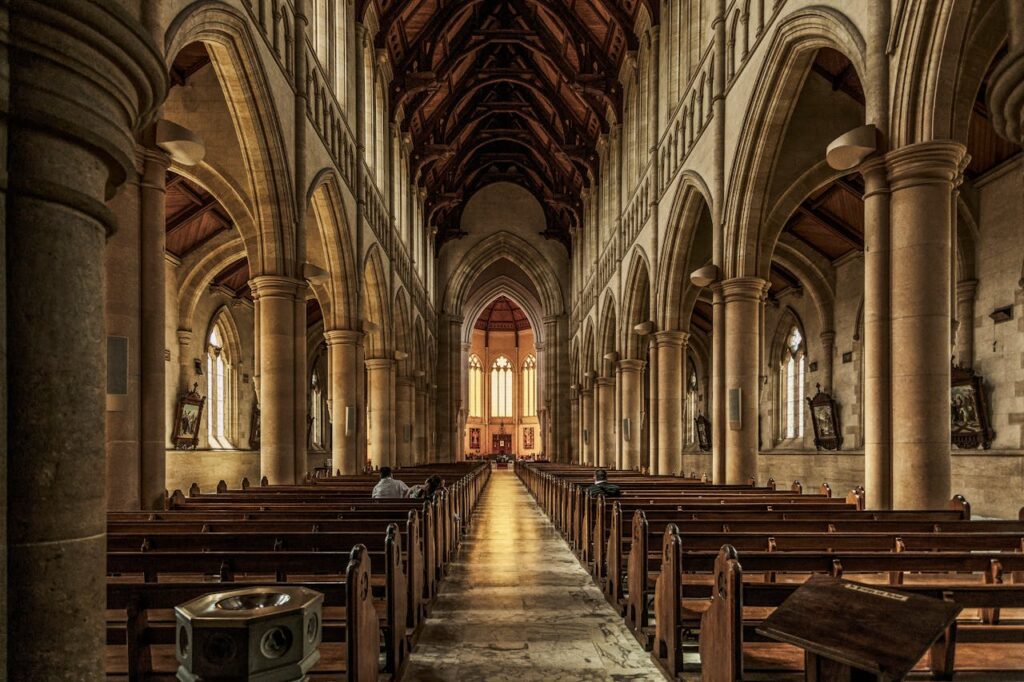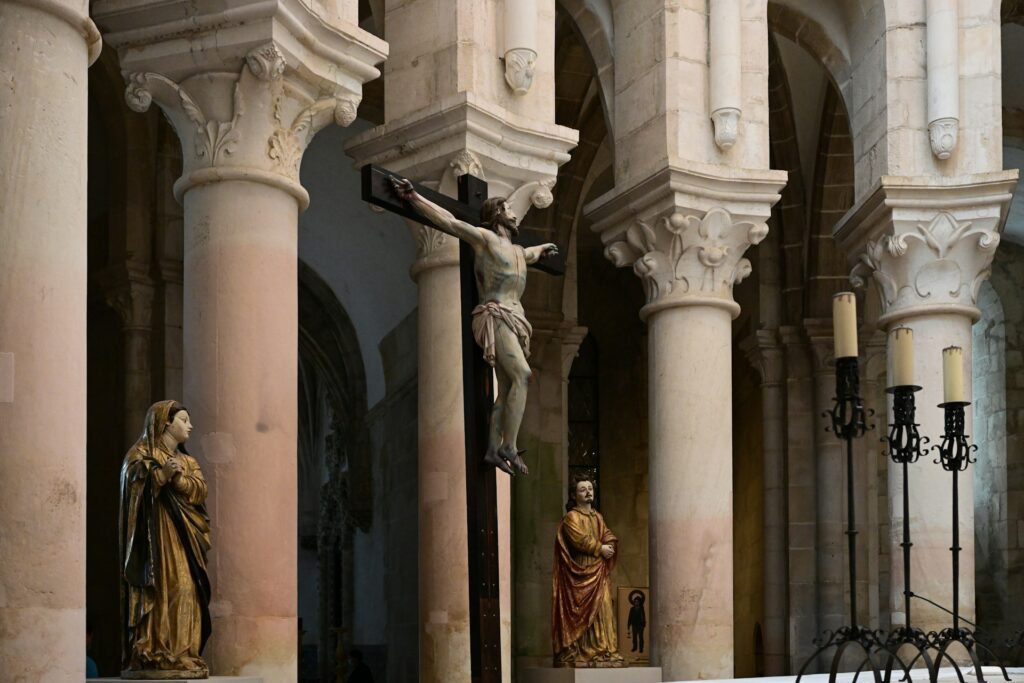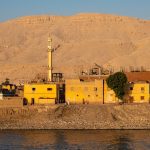Alcobaça Monastery – History and Facts
Introduction
The Alcobaça Monastery is an important historical and cultural landmark located in the town of Alcobaça in central Portugal. Built in the 12th century, this monastery is a magnificent example of Cistercian Gothic architecture and is also famous for the touching love story of Dom Pedro I and Inês de Castro. A UNESCO World Heritage Site, the Alcobaça Monastery attracts thousands of visitors annually. With its magnificent architecture, rich history and cultural significance, the monastery is an important landmark of Portugal.
Let’s start exploring this historic building in more depth, focusing on the curiosities about the Alcobaça Monastery
Building The Alcobaça Monastery
The construction of the monastery was a long process spanning centuries. It began in 1178, based on the architectural design of Clairvaux Abbey. After 45 years, in 1223, the monks moved into the partially completed monastery. The church, a significant milestone, was finished in 1252, marking it as the largest in the country and the first fully Gothic structure in Portugal.
The 13th century saw the addition of essential monastic spaces such as the Chapter House, Dormitory, Monks’ Room, and Refectory. A century later, a large cloister was constructed under the patronage of King Dinis.
Portugal’s prosperous “golden ages” allowed for further expansion, including the Library, New Sacristy, Upper Cloister, Kings’ Room, Palace, Conclusions Room, and Rachadouro Cloister. The final additions, completed in the late 17th and 18th centuries, consisted of the Reliquary Chapel, sculptures, Desterro Chapel, New Kitchen, and Tomb Room, culminating in a grand and opulent monastic complex.
Architectural Features of the Alcobaça Monastery

The Alcobaça Monastery is one of the most striking examples of Gothic architecture, combining simplicity and splendor. The exterior of the monastery is unadorned, faithful to the simplicity of Cistercian architecture. The white stone walls offer a simple elegance with their untreated surfaces. The monastery’s imposing church, on the other hand, is characteristic of the Gothic style, with pointed arches, ribbed vaults and elongated columns. The church’s massive dimensions and high ceilings aim to inspire spiritual awe. The large windows allow plenty of natural light into the interior, creating a bright and spacious atmosphere. Interior decorations are kept to a minimum, creating a serene environment that encourages a focus on spirituality.
The other buildings of the monastery also bear traces of the Gothic style, but with a simpler and more functional design compared to the church. The spacious courtyards add to the peaceful atmosphere of the monastery. Elegant porticoes, fountains and gardens add subtle touches to the architectural richness. The monastic complex perfectly blends the elegance and splendor of Gothic architecture with the simplicity of the Cistercian order, creating a structure that is both architecturally impressive and spiritually peaceful.
A Tragic Love Story
The amorous story of Alcobaça Monastery begins at the beginning of the 14th century with the love between Dom Pedro (Pedro I), a member of the royal family of Portugal, and Inês de Castro, a Spanish noblewoman. Dom Pedro is the son of King Afonso III of Portugal and the one chosen for his marriage is Constanza de Castro, a Spanish noblewoman.
However, despite his marriage to Constanza, Dom Pedro burns with a deep passion for Inês de Castro. Even after his marriage to Constanza, Dom Pedro continues his relationship with Inês and his love for her grows stronger every day.
This forbidden love is further revealed after the death of Afonso III. After the death of Afonso III, Dom Pedro ascends to the throne and publicly reveals his affair with Inês. However, the situation threatens the political balance in Portugal and some people are unhappy, especially because Inês is of Spanish origin.
This discontent led a group of nobles to conspire against Inês. In 1355, these nobles murdered Inês de Castro in Dom Pedro’s palace. This event plunged Dom Pedro into deep grief and he vowed revenge.
A few years later, Dom Pedro took his revenge and punished the nobles. More importantly, he exhumes the corpse of Inês de Castro and shows her in a public ceremony as a crowned queen, prominently displayed in the royal palace.
After Dom Pedro’s death, his and Inês de Castro’s graves were moved to the Alcobaça Convent. This is a sign that their love will last forever. Inside the monastery, the graves of Dom Pedro and Inês de Castro are placed facing each other, symbolizing their undying love.
The Alcobaça Monastery is famous for this true love story and offers visitors an experience full of history and passion.

Alcobaça Monastery Visitor’s Guide
Alcobaça Monastery is one of Portugal’s most important historical and cultural symbols. Here is our guide for those who want to visit this magnificent structure:
Admission Fees and Visiting Hours
Alcobaça Monastery is usually open from 9 am to 6 pm.As weekends and holidays may be crowded, consider visiting during early hours.
How to Get There?
Alcobaça Monastery is located in the city of Alcobaça, Portugal. It’s about a 1.5-hour drive from Lisbon if you’re renting a car. You can also reach Alcobaça by train. Trains departing from Lisbon provide transportation to Alcobaça.
Visiting Tips
- Join guided tours to appreciate the architectural details and historical significance of the monastery.
- Visit the tombs of Pedro and Inês and learn about their famous love story.
- Explore the churches, courtyards, and gardens inside the monastery and savor the architectural elegance.
- Visit the visitor center to learn about the monastery’s restoration process and conservation efforts.
Practical Information
- Taking photographs inside the monastery is generally allowed, but it may be restricted in some specific areas.
- Be respectful of the monks and the monastery community, and maintain a quiet demeanor.
- You can purchase souvenirs from the gift shops around the monastery or taste local delicacies.
Other Recommended Activities
Take a walk through the historic streets of Alcobaça and try traditional Portuguese cuisine at local restaurants. Consider visiting Batalha Monastery near Alcobaça Royal Monastery and the seaside town of Nazaré.
Frequently Asked Questions About Alcobaça Monastery
Where is Alcobaça Monastery located?
Alcobaça Monastery is located in the town of Alcobaça, which is in central Portugal, approximately 120 kilometers north of Lisbon.
What is the history behind Alcobaça Monastery?
Alcobaça Monastery, also known as Mosteiro de Santa Maria de Alcobaça, was founded in 1153 by the first Portuguese king, Afonso Henriques. It holds significant historical importance, particularly due to its association with the tragic love story of Dom Pedro I and Inês de Castro.
Can visitors enter Alcobaça Monastery?
Yes, visitors can enter Alcobaça Monastery. It is open to the public for tours, allowing visitors to explore its stunning architecture, historical artifacts, and learn about its rich cultural heritage.
What is the significance of Alcobaça Monastery in Portuguese history?
Alcobaça Monastery is significant in Portuguese history as a symbol of both religious devotion and cultural heritage. It is also renowned for the story of Dom Pedro I and Inês de Castro, which has become an integral part of Portuguese folklore.
Is Alcobaça Monastery a UNESCO World Heritage Site?
Yes, Alcobaça Monastery is a UNESCO World Heritage Site. It was inscribed on the list in 1989 in recognition of its outstanding universal value as an exceptional example of Cistercian Gothic architecture and its historical significance within Portuguese culture.
What architectural features make Alcobaça Monastery unique?
Alcobaça Monastery is renowned for its impressive Cistercian Gothic architecture, characterized by its grand scale, elegant rose window, and intricate stone carvings. The monastery’s layout, with its imposing church and cloistered courtyards, reflects the principles of Cistercian monasticism.
Are there any special events or ceremonies held at Alcobaça Monastery?
Yes, Alcobaça Monastery hosts various cultural events and religious ceremonies throughout the year. These may include concerts, exhibitions, religious services, and commemorations of significant historical events related to the monastery’s past.
Can visitors see the tombs of Dom Pedro I and Inês de Castro at Alcobaça Monastery?
Yes, visitors can view the ornate tombs of Dom Pedro I and Inês de Castro inside Alcobaça Monastery’s church. The tombs are masterpieces of medieval sculpture and are located side by side, symbolizing the enduring love between the two figures.
Is photography allowed inside Alcobaça Monastery?
Photography is permitted inside Alcobaça Monastery for personal use. However, visitors are usually asked to refrain from using flash photography and to be respectful of the sacred and historical nature of the site.
How long does it take to visit Alcobaça Monastery?
The duration of a visit to Alcobaça Monastery can vary depending on individual interests. On average, visitors spend approximately one to two hours exploring the monastery, including the church, cloisters, and museum areas. However, those with a keen interest in history and architecture may choose to spend more time admiring the details of this remarkable site.










